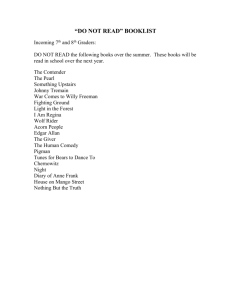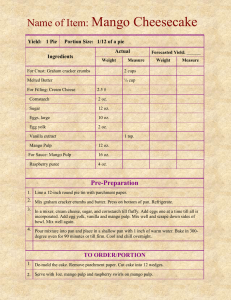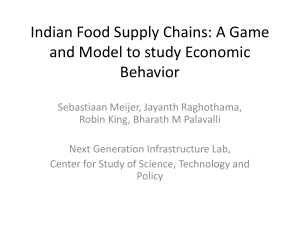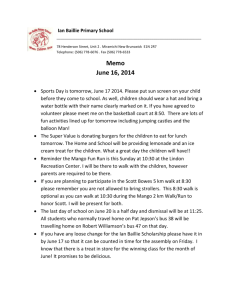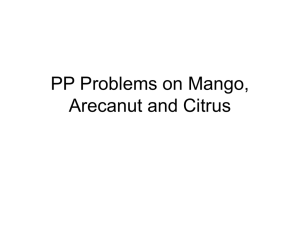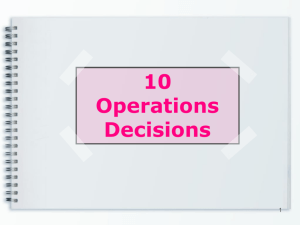Document 13310169
advertisement
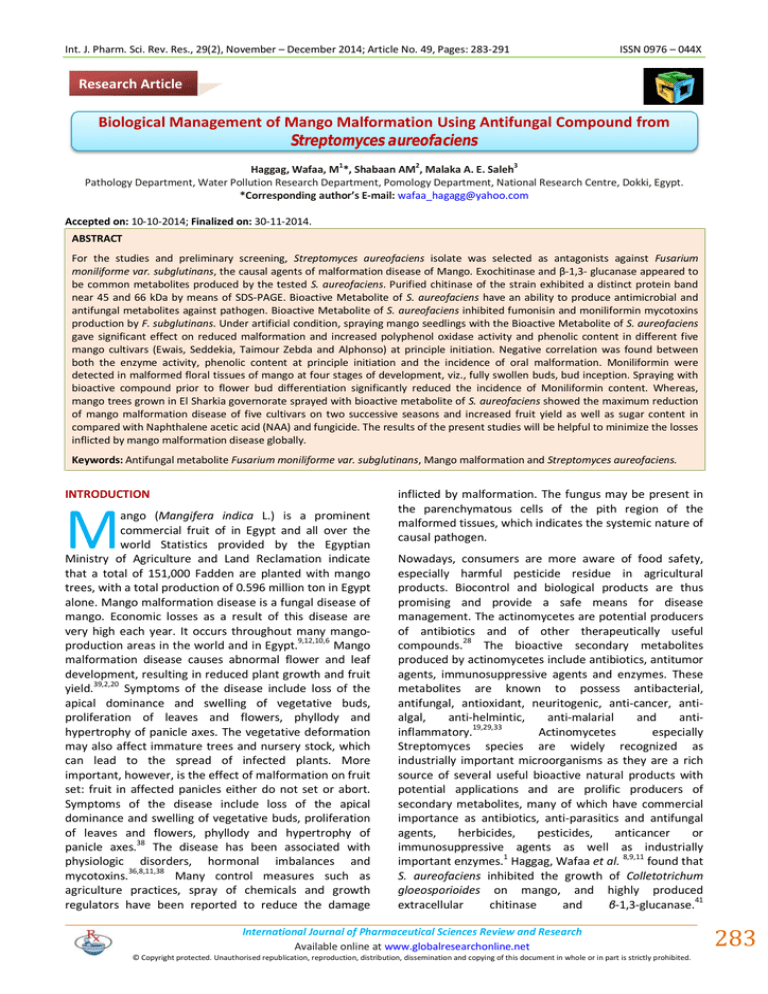
Int. J. Pharm. Sci. Rev. Res., 29(2), November – December 2014; Article No. 49, Pages: 283-291 ISSN 0976 – 044X Research Article Biological Management of Mango Malformation Using Antifungal Compound from Streptomyces aureofaciens 1 2 3 Haggag, Wafaa, M *, Shabaan AM , Malaka A. E. Saleh Pathology Department, Water Pollution Research Department, Pomology Department, National Research Centre, Dokki, Egypt. *Corresponding author’s E-mail: wafaa_hagagg@yahoo.com Accepted on: 10-10-2014; Finalized on: 30-11-2014. ABSTRACT For the studies and preliminary screening, Streptomyces aureofaciens isolate was selected as antagonists against Fusarium moniliforme var. subglutinans, the causal agents of malformation disease of Mango. Exochitinase and β-1,3- glucanase appeared to be common metabolites produced by the tested S. aureofaciens. Purified chitinase of the strain exhibited a distinct protein band near 45 and 66 kDa by means of SDS-PAGE. Bioactive Metabolite of S. aureofaciens have an ability to produce antimicrobial and antifungal metabolites against pathogen. Bioactive Metabolite of S. aureofaciens inhibited fumonisin and moniliformin mycotoxins production by F. subglutinans. Under artificial condition, spraying mango seedlings with the Bioactive Metabolite of S. aureofaciens gave significant effect on reduced malformation and increased polyphenol oxidase activity and phenolic content in different five mango cultivars (Ewais, Seddekia, Taimour Zebda and Alphonso) at principle initiation. Negative correlation was found between both the enzyme activity, phenolic content at principle initiation and the incidence of oral malformation. Moniliformin were detected in malformed floral tissues of mango at four stages of development, viz., fully swollen buds, bud inception. Spraying with bioactive compound prior to flower bud differentiation significantly reduced the incidence of Moniliformin content. Whereas, mango trees grown in El Sharkia governorate sprayed with bioactive metabolite of S. aureofaciens showed the maximum reduction of mango malformation disease of five cultivars on two successive seasons and increased fruit yield as well as sugar content in compared with Naphthalene acetic acid (NAA) and fungicide. The results of the present studies will be helpful to minimize the losses inflicted by mango malformation disease globally. Keywords: Antifungal metabolite Fusarium moniliforme var. subglutinans, Mango malformation and Streptomyces aureofaciens. INTRODUCTION M ango (Mangifera indica L.) is a prominent commercial fruit of in Egypt and all over the world Statistics provided by the Egyptian Ministry of Agriculture and Land Reclamation indicate that a total of 151,000 Fadden are planted with mango trees, with a total production of 0.596 million ton in Egypt alone. Mango malformation disease is a fungal disease of mango. Economic losses as a result of this disease are very high each year. It occurs throughout many mangoproduction areas in the world and in Egypt.9,12,10,6 Mango malformation disease causes abnormal flower and leaf development, resulting in reduced plant growth and fruit 39,2,20 yield. Symptoms of the disease include loss of the apical dominance and swelling of vegetative buds, proliferation of leaves and flowers, phyllody and hypertrophy of panicle axes. The vegetative deformation may also affect immature trees and nursery stock, which can lead to the spread of infected plants. More important, however, is the effect of malformation on fruit set: fruit in affected panicles either do not set or abort. Symptoms of the disease include loss of the apical dominance and swelling of vegetative buds, proliferation of leaves and flowers, phyllody and hypertrophy of panicle axes.38 The disease has been associated with physiologic disorders, hormonal imbalances and mycotoxins.36,8,11,38 Many control measures such as agriculture practices, spray of chemicals and growth regulators have been reported to reduce the damage inflicted by malformation. The fungus may be present in the parenchymatous cells of the pith region of the malformed tissues, which indicates the systemic nature of causal pathogen. Nowadays, consumers are more aware of food safety, especially harmful pesticide residue in agricultural products. Biocontrol and biological products are thus promising and provide a safe means for disease management. The actinomycetes are potential producers of antibiotics and of other therapeutically useful compounds.28 The bioactive secondary metabolites produced by actinomycetes include antibiotics, antitumor agents, immunosuppressive agents and enzymes. These metabolites are known to possess antibacterial, antifungal, antioxidant, neuritogenic, anti-cancer, antialgal, anti-helmintic, anti-malarial and anti19,29,33 inflammatory. Actinomycetes especially Streptomyces species are widely recognized as industrially important microorganisms as they are a rich source of several useful bioactive natural products with potential applications and are prolific producers of secondary metabolites, many of which have commercial importance as antibiotics, anti-parasitics and antifungal agents, herbicides, pesticides, anticancer or immunosuppressive agents as well as industrially important enzymes.1 Haggag, Wafaa et al. 8,9,11 found that S. aureofaciens inhibited the growth of Colletotrichum gloeosporioides on mango, and highly produced extracellular chitinase and β-1,3-glucanase.41 International Journal of Pharmaceutical Sciences Review and Research Available online at www.globalresearchonline.net © Copyright protected. Unauthorised republication, reproduction, distribution, dissemination and copying of this document in whole or in part is strictly prohibited. 283 © Copyright pro Int. J. Pharm. Sci. Rev. Res., 29(2), November – December 2014; Article No. 49, Pages: 283-291 Actinomycetes have proved their ability to produce a variety of bioactive secondary metabolites and for this reason, the discovery of novel antibiotic and enzymes lead molecules through microbial secondary metabolite 36 screening is becoming increasingly important. We discovered novel biologically active secondary metabolites against the pathogenic Fusarium moniliforme var. subglutinans. The aim of our work is to develop of antifungal metabolite from Streptomyces aureofaciens to control mango malformation disease in vitro and in vivo. MATERIAL AND METHODS Organisms and media Fusarium moniliforme var. subglutinans was previously isolated 6,10 from mango malformed disease, maintained on potato dextrose agar (PDA) slants and stored at 4°C. S. aureofaciens was previously isolated from the root tissues of mango trees. The culture was maintained on MGYP slants having the composition (%): malt extract 0.3, glucose 1.0, yeast extract 0.3, peptone 0.5 and agar 2.0.23 The pH of the medium was adjusted to 6.4 to 6.8 and culture was incubated at 30oC for 48 h. Sub culturing was carried out once in 2 weeks and the culture was stored at 4oC. Culture medium was optimized previously by a factorial design (data not shown) in order to increase the biomass growth. This optimization was based on the carbon/nitrogen ratio. Cultures in 10- and 1,000-L bioreactors were also grown in a newly modified enriched culture media. The pH was controlled within 7.0±0.2 by an on-off control adding H3PO4 (40 %). All fermentations were conducted at 30 °C using an agitation speed of 205 rpm and a total gas flow rate of 5.0 L/min (0.5 vol per vol per min (vvm). Dissolved oxygen tension, temperature, agitation, and pH were displayed online and stored in a hard drive for further analysis using a homemade data acquisition control system. Determination of the enzymatic activities β-1, 3-Glucanase assay β-1, 3-Glucanase activity was estimated according to the rate of reducing-sugar production with laminarin reduced 5 by NaBH4 treatment as the substrate . Glucose was used as a standard. One unit of activity is defined as the amount of enzyme producing 1 mmol/min of glucose equivalents at 40°C.35 Protease assay Protease activity of culture broth or culture mass extract was determined by a modified Anson's method.35 One unit of protease activity was defined as the amount of enzyme that produced an absorbance at 280 nm. Chitinase assay Extracellular chitinase activity was determined by incubating 1 ml of crude enzyme with 1 ml of 1% colloidal chitin in a 0.05M phosphate buffer, pH 7.0 at 35°C for 1 h ISSN 0976 – 044X 26 using N-acetyl-D-glucosamine (NAG) as a standard. One unit of chitinase activity was defined as the amount of enzyme, which produces 1 µ mole of N-acetyl glucosamine in 1 ml of reaction mixture under standard assay condition. Purification of chitinase A single-step purification of chitinases was performed according to the method suggested by Nawani and Kapadnis.24 The culture filtrate (500 mL) of 60-h old culture broth was subjected to precipitation with ammonium sulphate to 80% saturation and kept at 4ºC for 24 h. The protein concentrate was loaded on Sephadex G-100 (Sigma, USA) column (2x40 cm) preequilibrated with a 0.01M citrate phosphate buffer, pH 6 and eluted with the same buffer. Fractions thus collected were tested for chitinolytic activity. Chitinolytic active fractions were recovered and concentrated. Enzyme concentrate thus obtained through a gel filtration was checked for purity by SDS-PAGE and its molecular weight was determined by comparing with known standard proteins. SDS-PAGE was carried out in a 2 mm slab gel of 10% acrylamide in a Tris-HCl buffer (pH 8.0) containing 0.1% SDS. Enzyme samples of 20 µL were loaded into the wells. The bands present on the gels were observed and compared with standard proteins. SDS-PAGE broadmolecular weight range proteins were used as standard proteins (Bio-Rad, USA). Extraction of secondary metabolites After 96hrs the fermented broth was extracted twice with ethyl acetate and shaken vigorously for 1hr for complete extraction. The ethyl acetate phase that contains bioactive compound was separated from the aqueous phase and was evaporated to dryness under reduced vacuum 80°-90°C.40 The concentrated organic residue obtained was used to determine the antimicrobial activity. Biological assays Antagonistic activity of cells or bioactive metabolites secreted by S. aureofaciens was measured as growth reductions of target pathogen, where volume of S. aureofaciens culture filtrate was added to pathogen medium. Minimum Inhibitory Concentration (MIC) of metabolic compounds was determined against a variety of microorganisms, including both Gram-positive and Gram-negative bacteria, yeast and fungi have been carried out. The minimum inhibitory concentration (MIC) has been determined by the diffusion method. The antifungal activity of metabolites of actinomycetes against pathogenic fungi was evaluated by the modified 17 agar well diffusion method. Supernatant fluids was sterilized and 25 ml were aseptically dispensed in 125-ml Erlenmeyer flasks before being inoculated with 0.1 ml of a spore suspension of F. subglutinans containing 104 CFU/ml. Cultures were 0 incubated at 25 C for 10 days and analyzed for International Journal of Pharmaceutical Sciences Review and Research Available online at www.globalresearchonline.net © Copyright protected. Unauthorised republication, reproduction, distribution, dissemination and copying of this document in whole or in part is strictly prohibited. 284 © Copyright pro Int. J. Pharm. Sci. Rev. Res., 29(2), November – December 2014; Article No. 49, Pages: 283-291 moniliformin and fumonisin production. The moniliformin was evaluated by integration at 230nm. And determined by reference to calibration curves established with 21,33 standard by HPLC. Fumonisin was quantified by HPLC. Peak identity was determined by means of retention time and UV spectra that were recorded for all samples in the range 200–400 nm. Greenhouse experiment Experiment was carried out on mango under artificial infection by Fusarium at greenhouse to determine the efficacy of the culture filtrate of S. aureofaciens against malformation. Fusarium inoculum was prepared to a fine powder and thoroughly mixed with commercial peat moss/perlite growing media at a concentration of 3 x 105 colony forming units per one gram. Inoculum- growing media mixtures were placed into plastic containers (30 cm in diameter) which had previously been sterilized by o autoclave (110 C for 10 min). Transplanting of mango Awis, Sedeek, Timour, Alfonso and Zebda cvs. (2 year. Old) were sown into previous pots. Following transplanting, seedlings were watered to activate Fusarium inoculums (cfu X 104). Four replications of three seedlings each were evaluated. A fully replicated set of 10 seedlings was included as a control, which were transplanted into peat/perlite growing media without fungal inoculum. Transplanting of mango was sprayed till run-off with approximately 100 ml of spray solution per transplanting. The culture filtrate of Streptomyces at 1:5 concentrations was sprayed using a knapsack sprayer. NAA (2000 ppm) and fungicide (Tobseen) were used as a check treatment . Mango transplanted seedlings were monitored for development of malformation. When seedlings were considered malformed, they were carefully extracted from plastic containers, their malformed part as well as roots thoroughly washed to remove adhering particles of growing media, and analyzed in the laboratory for colonization by inoculated isolates. Fully swollen oral buds at panicle emergence, were used for measuring enzyme activity and phenolic contents. Healthy and malformed panicles in each variety were counted and averaged for calculating malformation incidence. Correlations between enzyme activities and percent malformed panicles were calculated. Estimation of phenolic content Phenolic contents were measured using the Folin Ciocalteu reagent method suggested by Slinkard and Singleton 34 and malformein are represented as mg /g of fresh tissue full buds weight. Enzyme assay Catecholase activity was measured spectrophotometrically at 400 nm as per the procedure 32 described by Sanchez-Ferrer et al. Catecholase activity was measured using 30 mM 4- methyl catechol (4MC), as substrate, made in 10 mM sodium accetate buffer pH 4.5. To 1 ml crude enzyme extract, 3 ml of 100 mM phosphate buffer pH 7.3 was added. To this mixture, 1 ml substrate ISSN 0976 – 044X was added at zero time. The change in absorbance at 400 nm was recorded in a CL-1200 spectrophotometer. The enzyme activity was represented as change in absorbance at 400 nm/g of tissue weight/min (DA400 g ÿ1 minÿ1). Field Experiment Two field experiments were conducted under natural infested conditions, using the five susceptible cultivars i.e. Awis, Sedeek, Timour, Alfonso and Zebda, (10 yr-old) in El Shrkia Governorate. Three foliar sprayers were applied, the first one on the middle of October (Vegetative growth stage) , meanwhile, the second and third sprayers at 30 d intervals starting from 15th January (about one month before normal flowering) in two successive seasons. The fermented of bioactive components was used at (1: 5) conc. mixed with glycerol, soybean oil and tween 80 and sprayed using a knapsack sprayer. Trees sprayed with water, NAA (2000 ppm) and fungicide served as a check treatment. Trees were sprayed till run-off (2L/tree). Treatments were assigned in a randomized complete block design. Plots consisting of three mango trees were replicated five times. Irrigation, fertilization and other cultural practices were carried out as recommended. The disease incidence was determined as percentage of infected blossom at 30 days interval during the growing season. Fruit sets numbers and yield was evaluated at harvesting stage. Total sugars (%) were determined by the formula 25x(X/Z). Where X is the volume (ml) of standard sugar solution used against 10 ml of Fehling’s solution and Z is the volume (ml) of sample aliquot used against 10 ml of Fehling’s solution. Reducing sugars (%) were determined by using the formula 6.25 x (X/Y). Where X is the volume in ml of standard sugar solution used against 10 ml of Fehling’s solution and Y is the volume (ml) of sample aliquot used against 10 ml of Fehling’s solution.30 Statistical analysis The collected data were evaluated statistically using the software SPSS for Windows (release 7.5.1, 20 December 1996; SPSS Inc., Chicago, IL). RESULTS Enzymes assays S. aureofaciens have ability to produce secondary metabolites include hydrolysis enzymes was determined (Figure 1). Secondary metabolites were increased in optimized medium. The highest production of chitinase, protease and β-1,3- glucanase by the tested S. aureofaciens in shaken broth culture occurred till 16 days. The purified enzyme was subjected to SDS-PAGE for determination of molecular weight of the protein. The partially purified enzyme exhibited a protein band near 45 and 66 kDa (Figure 2). International Journal of Pharmaceutical Sciences Review and Research Available online at www.globalresearchonline.net © Copyright protected. Unauthorised republication, reproduction, distribution, dissemination and copying of this document in whole or in part is strictly prohibited. 285 © Copyright pro Int. J. Pharm. Sci. Rev. Res., 29(2), November – December 2014; Article No. 49, Pages: 283-291 ISSN 0976 – 044X Table 1: Antimicrobial activities of the bioactive metabolite produced by S. aureofaciens against different test organisms. Figure 1: Production of antifungal hydrolysis enzymes by Streptomyces aureofaciens Figure 2: SDS-PAGE aureofaciens. chitinase from Test organism Activity MIC(µg/ml) Bacillus subtilis +++ 12.0 Staphylococcus aureus + 19.40 Escherichia coli + 17.5 Candida albicans ++ 10.2 Aspergillus niger + 26.7 Aspergillus flavus + 25.1 Aspergillus fumigatus + 23.7 Fusarium moniliforme ++ 30.4 Fusarium germanium ++ 23.2 Fusarium oxysporum ++ 24.6 Streptomyces Antifungal and Antimicrobial activities Data showed that, the bioactive metabolite produced of S. aureofaciens was highly active against all test microorganisms (Table 1). The minimum inhibitory concentration (MIC) was determined as a clear zone (mm) around the paper discs loaded with different concentration of bioactive compound of each concentration were spotted on paper discs. Bioactive metabolite of S. aureofaciens showed antifungal activity against Fusarium growth expressed (Figure 3). The highest reduction was recorded at 1:5 concentration. In vitro antifungal activity of bioactive metabolite of S. aureofaciens. Using HPLC analysis, high concentration of Moniliformin and fumonisin were obtained in the culture filtrate of Fusarium (Figure 3) Bioactive metabolite of S. aureofaciens isolate inhibited mycotoxins production of F. subglutinans. Compelate inhibition was detected of both mycotoxins. Figure 3: In vitro antifungal bioactivity of fermentation bioactive metabolite of Streptomyces aureofaciens on F. subglutinans growth and mycotoxins production. Greenhouse experiment The efficacies of the bioactive metabloite produced by of S. aureofaciens at 1:5 concentrations against vegetative buds malformation disease of mango seedlings under artificial infested conditions were determined using Sedeek, Timour, Alfonso and Zebda cultivars. Data in Figure (4) show that all tested mango cultivars were susceptible to infection by F. moniliforme under artificial infested conditions. Data also show that spraying seedlings with the purified active substance produced by S. aureofaciens gave significant effect on reducing disease incidence in all cultivars compared to untreated control. Enzyme activities and phenolic content were measured in different mango cultivars at panicle initiation. Enzyme International Journal of Pharmaceutical Sciences Review and Research Available online at www.globalresearchonline.net © Copyright protected. Unauthorised republication, reproduction, distribution, dissemination and copying of this document in whole or in part is strictly prohibited. 286 © Copyright pro Int. J. Pharm. Sci. Rev. Res., 29(2), November – December 2014; Article No. 49, Pages: 283-291 activity and phenolic content varied widely amongst eight cultivars, strong negative correlation was found between both the enzyme activity, phenolic content at panicle initiation and the incidence of oral malformation (Table 2). Strong negative correlations between Polyphenol oxidase activity, phenolic content in different mango cultivars at panicle initiation and malformation incidence were observed. Data also show that spraying seedlings with the purified active substance produced by S. aureofaciens gave significant effect on increased Polyphenol oxidase activity, phenolic content At the same time, positive correction with S. aureofaciens and reduction of malformin in bud tissue in compared with NAA, fungicides and untreated control (Table 2). ISSN 0976 – 044X Ewais, Seddekia, Taimour Zebda and Alphonso to control mango malformation disease under natural conditions at Ismailia governorate in two seasons Table 3. Malformation disease was higher on flowers blossom clusters than in vegetative buds in untreated control in both seasons. Treated tree with bioactive metabolite product of S. aureofaciens greatly reduced mango malformation disease in compared with NAA and fungicide. In addition it increased fruit sets of all cultivars in both seasons (Table 4) in compared to untreated control, NAA and fungicide of all cultivars in both seasons (Figure 5). Bioactive metabolite treatment has significantly increased the fruit yield compared to untreated control and fungicide. Since, higher increase in fruit yield and sugar content were obtained when the trees were sprayed with NAA by kg/ tree in compared with kg/ tree in untreated control and fungicide (Tobseen) (Table 4). DISCUSSION Figure 4: Efficacy of foliar sprays of fermentation bioactive metabolite of S. aureofaciens on the incidence of vegetative buds malformation of mango seedlings, Ewais, Seddekia, Taimour Zebda and Alphonso cultivars under artificial infested conditions Figure 5: Efficacy of three foliar sprays of fermentation bioactive metabolite of S. aureofaciens on the incidence of malformation disease and fruit yield of Awais mango cultivar in Sharkia governorate. A- Control Malformation B- Streptomyces treatment Field experiment Malformation is the major impediment to the establishment of economically profitable orchards. It is intriguing the scientists because of its destructive and widespread nature.9,20,22 Malformation is a serious problem of mango industry and has become a limiting factor in the establishment of economically viable orchards. Despite hectic efforts, complete control has not been achieved yet. Floral malformation is most important because it directly hits the yield of the plants leaving unproductive inflorescences.2,3,9 It causes deformation of vegetative and floral tissues in mango.3 Management of malformation can be difficult which the fungus F. mangiferae has a specifically localized distribution within malformed mango trees. In general, the protected, internal location of the pathogen in affected trees makes it difficult to control this disease. Early removal of affected vegetative and floral terminals reduces intensity of malformation.27 The desired effects of the use of biological control agents in crop protection have drawn attention to integrated disease management.14 The advantage of using BCAs is that biochemistry and physiology of production of antibiotic antimicrobial 14 substances is well documented . In order to provide tools for integrated agriculture, biological control offers an eco-friendly alternative to the use of synthetic fungicides for controlling plant diseases, and the bioactive compound. The use of antagonistic micro-organisms, such as Streptomyces species, is an ideal method of controlling plant diseases. As stated in several reports, Streptomyces activity in plants not only protects against pathogens, but the metabolic products of Streptomyces also influence 37 plant growth and physiology. Our paper showed that S. aureofaciens produced antifungal hydrolysis enzymes and bioactive metabolite had the ability to exhibit high antifungal activity in vitro against Fusarium growth and mycotoxins production as well as antimicrobial activity. Bioactive metabolite product of S. aureofaciens was applied in a large scale using susceptible cultivars i.e. International Journal of Pharmaceutical Sciences Review and Research Available online at www.globalresearchonline.net © Copyright protected. Unauthorised republication, reproduction, distribution, dissemination and copying of this document in whole or in part is strictly prohibited. 287 © Copyright pro Int. J. Pharm. Sci. Rev. Res., 29(2), November – December 2014; Article No. 49, Pages: 283-291 ISSN 0976 – 044X Table 2: Efficacy of foliar application of fermentation bioactive metabolite of S. aureofaciens on Polyphenol oxidase activity, phenolic and moniformin contents in different mango cultivars at panicle initiation Ewais Treatment Polyph enol oxidase activity Phen olic conten t (mg g f.w) Control Saddika Alphonso Taimour monilifor min Polyph enol oxidase activity Phen olic conten t (mg g f.w) monilifor min Polyph enol oxidase activity Phen olic conten t (mg g f.w) monilifor min Polyph enol oxidase activity Phen olic conten t (mg g f.w) Zebda monilifor min Polyph enol oxidase activity Phen olic conten t (mg g f.w) monilifor min 9.3 0.98 4.34 8.5 0.93 2.87 9.6 1.4 4.76 13.7 1.4 2.43 18.7 1.7 3.21 S.aureofaci ens 15.7 1.5 0.65 17.5 1.4 0.76 18.4 1.7 0.87 21.3 1.9 0.67 33.7 2.4 0.45 NAA 11.6 1.1 3.23 12.3 1.1 1.75 13.2 1.2 2.87 15.8 1.6 1.87 23.3 1.9 2.43 Fungicide 10.7 0.97 3.12 9.4 0.98 2.1 9.9 1.5 3.3 13.8 1.4 2.10 19.7 1.8 3.12 LSD 0.3 0.2 0.34 0.3 0.3 0.54 0.4 0.2 0.65 0.5 0.2 0.60 0.4 0.6 0.43 Table 3: Efficacy of three foliar application of fermentation bioactive metabolite of S. aureofaciens on mango malformation disease incidence in two successive seasons in Sharkia governorate. Percentage of disease incidence % Stage Treatment Ewais Season I Vegetative Flowering Saddika Season II Season I Alphonso Season II Season I Taimour Season II Season I Zebda Season II Season I Season II Control 23.1 22.9 32.1 27.1 39.4 34.2 45.2 44.6 15.4 21.1 S. aureofaciens 2.87 2.33 2.7 2.9 2.3 2.4 1.9 1.7 0.8 0.9 NAA 11.2 3.31 18.8 18.9 15.7 16.8 11.3 9.8 8.8 12.5 Fungicide 23.4 20.1 25.1 24.7 24.2 21.2 22.1 17.3 12.0 11.5 Control 53.1 56.4 48.6 45.8 40.2 45.9 38.6 33.6 12.2 14.7 S. aureofaciens 0.4 1.3 0.8 0.9 0.8 0.7 1.3 1.0 0.7 0.7 NAA 9.8 10.6 8.2 10.8 8.8 9.5 9.8 6.6 4.5 7.7 Fungicide 33.4 36.8 20.4 13.8 24.4 18.6 15.4 15.6 9.4 12.6 LSD 0.2 0.6 0.5 0.5 0.7 0.9 0.7 0.8 0.5 0.6 International Journal of Pharmaceutical Sciences Review and Research Available online at www.globalresearchonline.net © Copyright protected. Unauthorised republication, reproduction, distribution, dissemination and copying of this document in whole or in part is strictly prohibited. . . 288 © Copyright protected. Unauthorised republication, reproduction, distribution, dissemination and copying Int. J. Pharm. Sci. Rev. Res., 29(2), November – December 2014; Article No. 49, Pages: 283-291 ISSN 0976 – 044X Table 4: Efficacy of three foliar application of fermentation bioactive metabolite of S. aureofaciens on mango Fruit set, yield and sugar content in two successive seasons in Sharkia governorate. Ewais Treatment Fruit set numbers Yield Sugar Season I Saddika Season II Season I Alphonso Season II Season I Taimour Season II Season I Zebda Season II Season I Season II Control 49.1 33.9 21.2 22.2 31.4 18.8 22.1 27.1 21.1 20.2 S. aureofaciens 65.2 57.1 63.2 58.2 46.1 43.1 48.2 49.2 29.1 33.7 NAA 49.4 35.4 27.7 27.8 33.3 29.8 31.6 34.1 24.8 22.8 Fungicide (Tobseen) 41.0 32.3 23.1 22.2 24.7 19.9 21.2 14.5 25.1 24.9 Control 26.2 32.8 22.3 27.9 50.1 52.1 24.4 27.7 25.6 31.6 S. aureofaciens 47.1 66.1 49.2 44.1 62.3 69.2 46.2 46.4 40.3 49.7 NAA 27.3 30.3 22.1 28.6 55.5 53.3 32.3 52.2 29.4 38.1 Fungicide (Tobseen) 24.1 25.1 28.1 30.1 53.7 36.2 26.5 47.4 30.1 30.5 Control 28.2 27.2 16.4 17.4 23.2 31.6 20.2 22.2 11.3 12.3 S. aureofaciens 33.5 32.4 19.7 20.6 32.4 39.5 24.3 24.4 20.6 18.2 NAA 29.2 27.7 17.2 17.9 24.1 29.1 20.8 22.1 12.3 12.4 Fungicide (Tobseen) 28.4 30.6 17.2 17.8 24.7 30.8 18.4 20.1 11.2 12.5 LSD 3.2 4.0 3.2 4.4 5.4 5.2 3.2 3.5 3.2 3.5 Various publications have reported the successful use of antifungal metabolites extracted from Streptomyces spp. to control fungal pathogens.7 Under artificial condition, spraying seedlings with the bioactive components of S. aureofaciens gave significant effect on reduced malformation, moniliformin, and increased polyphenol oxidase activity and phenolic content in different mango cultivars at panicle initiation in compared with NAA and fungicide. The culture filtrate of this strain had also the ability to in vivo suppress infection of Fusarium on mango trees and increased yield and sugar content. Many species of actinomycetes, especially those belonging to the genus Streptomyces are well known as biocontrol agents that inhibit or lyse several soilborne and airborne plant pathogenic fungi.15, 35,19,26 A total of 50 actinomycetes isolates were isolated by serial dilution plate technique, of these 20 isolates showed activity against Bacillus Subtilis, Bacillus cereus, Escherichia coli, , Pseudomonas aeruginosa, Lactobacillus casei and Candida albicans.13 It is well known that Streptomyces sp. can produce industrially useful compounds, notably wide spectrum of antibiotics, as secondary metabolites, and continues to be screened for new bioactive compounds.4, 23,31 Under natural condition, application of bioactive metabolite on mango trees provided greater efficacy for controlling malformation disease in vegetative growth and in flowering stage, increased fruit set and yield. From the present investigation, it is apparent that the bioactive metabolite obtained from Streptomyces aureofaciens have antifungal and antimicrobial potential against a wide variety of microorganisms and filamentous fungi. Therefore, these Streptomyces can be considered for isolation of novel secondary metabolites which may be of importance for various biocontrol and applications. Use of biocontrol agents such as these broadspectrum Streptomyces isolate will probably be one of International Journal of Pharmaceutical Sciences Review and Research Available online at www.globalresearchonline.net © Copyright protected. Unauthorised republication, reproduction, distribution, dissemination and copying of this document in whole or in part is strictly prohibited. . . 289 © Copyright protected. Unauthorised republication, reproduction, distribution, dissemination and copying Int. J. Pharm. Sci. Rev. Res., 29(2), November – December 2014; Article No. 49, Pages: 283-291 the important tactics for plant disease management as they allow the reduced use of pesticides that are potential pollutants of the environment. REFERENCES ISSN 0976 – 044X 15. Haggag, Wafaa M, Abd El-Latif H, Purification and Synergistic activity of Extracellular Chitinase , β, 1-3 glucanase from Conithyrium minitans Against Sclerotinia sclerotiorum of Sunflowers, J. of Applied Sciences Research, 9(1), 2013, 55-61. 1. Atta MA, Ahmad MS, Antimycin-A antibiotic biosynthesis produced by Streptomyces sp. AZ-AR-262: taxonomy, fermentation, purification and biological activities, Australian J Basic Sci., 3, 2009, 126- 135. 16. Iqbal Z, Dasti AA, Saleem A, Role of Fusarium Mangiferae in causation of mangomal formation disease . Journal of Research (Science), Bahauddin Zakariya University, Multan, Pakistan, 17(1), 2006, 09-14. 2. Bhatnagar SS, Beniwal SPS, Involvement of Fusarium oxysporum in causation of mangomal formation, Plant Dis Rep., 61, 1977, 894–898. 3. Chakrabarti DK, Mango malformation, 1, Springer, 2011, 148. 17. Ismet A, Bukhari NA, Wijayanti DR, Bakir MA, Proteolytic activity of alkaliphilic, salt-tolerant actinomycetes from various regions in Saudi Arabia, Afr. J. Biotechnol., 11(16), 2012, 3849-3857. 4. 5. 6. 7. El-Tarabily KA, Rhizosphere competent isolates of streptomycete and non-streptomycete actinomycetes capable of producing cell-wall-degrading enzymes to control Pythium aphanidermatum damping-off disease of Cucumber, Can. J. Bot., 84, 211-222. Felix G, Meins F Jr, Purification, immunoassay and characterization of an abundant, cytokinin-regulated polypeptide in cultured tobacco tissues, Planta, 164, 1985, 423-428. Haggag Wafaa, Hazza M, Sehab A, Abd El-Wahab M., Epidemiology and the Association of the Fusarium Species with the Mango Malformation Disease in Egypt, Nature and Science, 8(4), 2010, 128-135. Haggag Wafaa M, Elham G, Abdallh, Purification and Characterization of Chitinase Produced by Endophytic Streptomyces hygroscopicus Against Some Phytopathogens, Journal of Microbiology Research, 2(5), 2012, 145-151. 8. Haggag Wafaa M, Hazza M, Sehab FS, Abd El-Wahab M, Mango Malformation: I. Toxin Production Associated with Fusarium Pathogens, American J. of Plant Science, 2(2), 2011, 276-281. 9. Haggag Wafaa M, Mango diseases in Egypt. Agriculture and Biolog, Journal of North America, 1(3), 2010, 285-28. 10. Haggag Wafaa M, Hazza M, Sehab A, Abd El-Wahab M, Scanning Electron Microcopy Studies on Mango Malformation, Nature and Science, 8(4), 2010, 122-127. 11. Haggag Wafaa M, Enas M, Mostafa and El Azzazy AM, Optimization and production of antifungal hydrolysis enzymes by Streptomyces aureofaciens against Colletotrichum gloeosporioides of mango, Agriculture Science, 2(2), 2011, 146-157. 12. Haggag, Wafaa and Abd Wahab, First Report of Fusarium sterilihyphosum and F. proliferatum-Induced Malformation Disease of Mango in Egypt. Journal of Plant Pathology: (Itali), 91(1), 2009, 231-240 (232). 13. Haggag, Wafaa and Radwan EL-Sehemy E, Screening of Marine Actinomycetes for their Antimicrobial and Antifungal Activities in Egypt, Int J Pharm Bio Sci., 5(4), 2014, (B) 527-536. 14. Haggag, Wafaa, Salme Timmusk, Colonization of peanut roots by biofilm-forming Paenibacillus polymyxa initiates biocontrol against crown rot disease, Journal of Appl Microbiol (UK), 104(4), 2008, 961-969. 18. Kavitha A, Prabhakar P, Muvva Vijayalakshmi a, Yenamandra Venkateswarlu, Purification and biological evaluation of the metabolites produced by Streptomyces sp. TK-VL_333, Research in Microbiology, 161, 2010, 335e345. 19. Kekuda TRP, Shobha KS, Onkarappa R, Studies on antioxidant and anthelmintic activity of two Streptomyces species isolated from Western Ghat soils of Agumbe, Karnataka, J Pharm Res., 3, 2010, 26-9. 20. Kumar P, Misra AK, Modi DR, Current status of mango malformation in India, Asian J Plant Sci., 10(1), 2011, 01– 23. 21. Miller JD, Epidemology of Fusarium ear diseases, 1994, 19-36. in J.D. Miller and H.L. Trenholm, eds. mycotoxins in grain. Eagan press, St. Paul, MN. 22. Misra AK, Pandey D, Singh VK, Mango malformation – an overview. In: U. Narain, K.Kumar, M. Srivastav, editors, Advances in plant diseases management. Mayapuri, New Delhi: Advance Publishing Concept (APC), 2000, 185–214. 23. Mukherjee G, SK Sen, Purification, Characterization, and antifungal activity of chitinase from Streptomyces venezuelae P10. Curr Microbiol, 53, 2006, 265-9 24. Nawani NN, Kapadnis BP, Production dynamics and characterization of chitinolytic system of Streptomyces sp. NK 1057, a well equipped chitin degrader, World J. Microbiol. Biotechnol., 20, 2004, 487494. 25. Nelson NJ, Colorimetric analysis of sugars, Methods Enzymol., 3, 1955, 85-86. 26. Og LS, GJ Choi, YH Choi, KS Jang, DJ Park, CJ Kim, JC Kim, Isolation and Characterization of Endophytic Actinomycetes from Chinese Cabbage Roots as Antagonists to Plasmodiophora brassicae, J. Microbiol. Biotechnol., 18, 2008, 1741-1746. 27. Ploetz RC, Zheng Q., Vazquez A, Sattar MA, Current status and impact of mango malformation in Egypt, Int. J. Pest Manag., 48, 2002, 279-285. 28. Rao KV, T Raghava RAO, Isolation and screening of antagonistic Actinomycetes from mangrove soil, Innovare Journal of Life Science, 1(3), 2013, 28-31. 29. Ravikumar S, Inbaneson SJ, Uthiraselvam M, Priya SR, Ramu A, Banerjee MB, Diversity of endophytic actinomycetes from Karangkadu mangrove ecosystem and its antibacterial potential against bacterial pathogens, J Pharm Res., 4, 2011, 294-6. International Journal of Pharmaceutical Sciences Review and Research Available online at www.globalresearchonline.net © Copyright protected. Unauthorised republication, reproduction, distribution, dissemination and copying of this document in whole or in part is strictly prohibited. 290 © Copyright pro Int. J. Pharm. Sci. Rev. Res., 29(2), November – December 2014; Article No. 49, Pages: 283-291 30. Reissig JL, Strominger JL, Leloir LF, A modified colorimetric method for the estimation of N-acetyl amino sugars, J Biol. Chem., 217, 1955, 959-966. ISSN 0976 – 044X CMUAc130 and its antagonism against phytopathogenic fungiAnnals of Microbiology, 53(4), 2003, 447-461. 31. Sahin N, Ugur A, Investigation of the antimicrobial activity of some Streptomyces isolates, Turkish Journal of Biology, 27, 2003, 79-84. 37. Taechowisan T, Lu C, Yuemao Shen and Saisamorn Lumyong, Secondary metabolites from endophytic Streptomyces aureofaciens CMUAc130 and their antifungal activity Microbiology, 151, 2005, 1691–1695. 32. Sanchez-Ferrer A, Bru R, Cabanes J, Garcia-Carmona F, Characterization of catecholase and cresolase activities of grape polyphenol oxidase, Phytochemistry, 27(2), 1988, 319-320. 38. Tapan N, Anitha G, Gurdeep BS, N Alok S, Pant R, Mango (Mangifera indica L.) malformation: Role of stress ethylene and cyanide, Physiology and Molecular Biology of Plants, 12(2), 2006, 163-165. 33. Scott PM, Lwrence GA, Liquid chromatographic determination and stability of the Fusarium mycotoxin moniliformin in cereal grains, J. Assoc. of. Anal. Chem., 70, 1987, 850-853. 39. Varma A, Lele V, Raychaudhuri S, Ram A, Preliminary investigations on epidemiology and control of mango malformation, Proc Ind Nat Sci Aca., 37, 1971, 291–300. 34. Linkard K, Singleton VL, Total phenol analysis: automation and comparison with manual methods, Am. J. Enol. Vitic., 28, 1977, 49-55. 35. Sousa C, AC Soares, M Garrido, Characterization of Streptomycetes with potential to promote plant growth and bio-control. Sci. Agric. (Piracicaba, Braz.), 65, 2008, 50-55. 40. Westley JW, Evans RH, Sello LH, Troupe N, Liu CM, Blount JF, Isolation and Characterization of antibiotic X-14547A, a novel monocarboxylic acid ionophore produced by Streptomyces antibioticus NRRL 8167, Journal of Antibiotics, 32(2), 1979, 100-107. (9)0000000 41. Yang SS, CI Huang, Protease production by amylolytic fungi in solid state fermentation, J. Chin. Agric. Chem. Soc., 32, 1940, 589-601. 36. Taechowisan T, JF Peberdy, S Lumyong, Chitinase production by endophytic Streptomyces aureofaciens Source of Support: Nil, Conflict of Interest: None. International Journal of Pharmaceutical Sciences Review and Research Available online at www.globalresearchonline.net © Copyright protected. Unauthorised republication, reproduction, distribution, dissemination and copying of this document in whole or in part is strictly prohibited. 291 © Copyright pro
